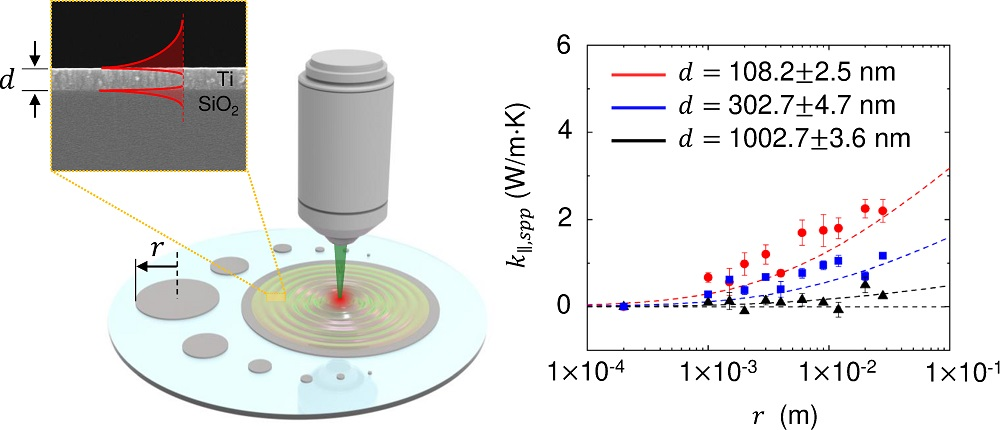The reliability and endurance of contemporary devices have been significantly impacted by the need to reduce the size of semiconductors and the issue of heat generated in hot spots of the devices not being efficiently distributed.

Schematic diagram of the principle of measuring the thermal conductivity of thin Titanium (TI) films and the thermal conductivity of surface plasmon polariton measured on the Ti film. Image Credit: Korea Advanced Institute of Science and Technology
The endeavor has proven beyond the capabilities of current devices’ thermal management systems. Therefore, the development of a novel method of heat dissipation based on surface waves formed on thin metal films over the substrate represents a significant advance.
For the first time, KAIST (President Kwang Hyung Lee) reported that Professor Bong Jae Lee’s research group in the Department of Mechanical Engineering had been successful in evaluating a newly detected transference of heat caused by “surface plasmon polariton” (SPP) in a thin metal film that had been produced on a substrate.
A surface wave called a surface plasmon polariton (SPP) is created on the surface of a metal as a result of a powerful interaction between the electromagnetic field at the metal’s interface with the dielectric and the free electrons there, along with other collectively vibrating particles.
The researchers improved thermal diffusion in nanoscale thin metal films by using surface plasmon polaritons (SPP), surface waves produced at the metal-dielectric interface. This novel heat transfer mode is extremely useful in the device manufacturing process and has the benefit of being able to be produced across a vast area since it happens when a thin layer of metal is formed on a substrate.
The study’s findings demonstrated that surface waves produced over a titanium (Ti) layer that was 100 nm thick and had a radius of about 3 cm enhanced the thermal conductivity by around 25%.
The significance of this research is that a new heat transfer mode using surface waves over a thin metal film deposited on a substrate with low processing difficulty was identified for the first time in the world. It can be applied as a nanoscale heat spreader to efficiently dissipate heat near the hot spots for easily overheatable semiconductor devices.
Bong Jae Lee, Professor, Korea Advanced Institute of Science and Technology
The outcome could be used to quickly disperse heat on a nanoscale thin layer, which has significant implications for the future development of high-performance semiconductor devices.
This new heat transfer mode, which the research team discovered, is expected to address the fundamental issue of thermal management in semiconductor devices because it allows for even more efficient heat transfer at nanoscale thickness, whereas the thermal conductivity of thin films typically declines due to the boundary scattering effect.
This research was chosen as an Editors’ Suggestion for Physical Review Letters and published online on April 26th, 2023. The Basic Research Laboratory Support Program of the National Research Foundation of Korea provided funding for the research.